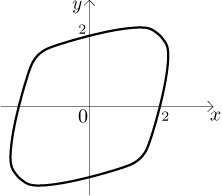Problem: Find the tangent line at the point
x4 − 4xy + y 4 = 16.
Solution: We can prove using the Implicit function theorem (see
Functions - Theory -
Implicit and parametric functions - Implicit functions) that on a
neighborhood of the given point
However, it is not possible to express y as a function of x explicitly from the given equation. Thus we find its derivative using implicit differentiation. First we take the given equation and differentiate both sides with respect to x, keeping in mind that y is in fact a function of x.
4x3 − 4y − 4xy′ + 4y 3y′ = 0.
Now we solve this equation for y′, then substitute into it
![]()
Now we know the slope of the tangent line and we can write its equation:
y − 2 = (1/4)⋅(x − 0), hence y = (1/4)⋅x + 2.
Remark: Finding out the shape of implicit curves is rather tricky. Probably the only thing one can see reasonably easily from the given equation is that the expression on the left is symmetric with respect to x and y, which means that the resulting shape will be symmetric with respect to the origin.
Using advanced tools (or a suitable software) it turns out that the shape looks like a rounded convex diamond elongated along the main diagonal.

By the way, the elongation is given by the middle term on the left in the
equation. Imagine that we put
Next problem
Back to Solved Problems - Implicit
and parametric functions